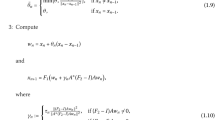Abstract
The aim of this paper is to define a generalized monotone mapping, which is the sum of symmetric cocoercive mapping and symmetric monotone mapping. The resolvent operator associated with generalized monotone mapping is defined and some of its properties are shown. We solve a variational inclusion problem using these new concepts. For illustration, some examples are given.
Similar content being viewed by others
References
Hassouni, A., Moudafi, A.: A perturbed algorithm for variational inclusions. J. Math. Anal. Appl. 185, 706–712 (1994)
Agarwal, R.P., Cho, Y.J., Huang, N.-J.: Sensitivity analysis for strongly nonlinear quasi-variational inclusions. Appl. Math. Lett. 13(6), 19–24 (2000)
Lee, B.S., Kang, M.K., Lee, S.J., Yang, K.H.: Variational inequalities for L-pseudomonotone maps. Nonlinear Anal. Forum. 6, 417–426 (2001)
Noor, M.A.: Extended general quasi-variational inequalities. Nonlinear Anal. Forum. 15, 33–39 (2010)
Noor, M.A.: Implicit iterative methods for nonconvex variational inequalities. J. Optim. Theory Appl. 143, 619–624 (2009)
Noor, M.A., Khalifa, K., Ahmed, K., Al-Bani, Khadija, Khattri, Sanjay, K.: On trifunction variational inequalities. Int. J. Nonlinear Sci. 11, 17–21 (2011)
Huang, N.-J., Fang, Y.-P.: Generalized m-accretive mappings in Banach spaces. J. Sichuan Univ. 38(4), 591–592 (2001)
Fang, Y.-P., Huang, N.-J.: H-monotone operator and resolvent operator technique for variational inclusions. Appl. Math. Comput. 145, 795–803 (2003)
Fang, Y.-P., Huang, N.-J.: H-accretive operators and resolvent operator technique for solving variational inclusions in Banach spaces. Appl. Math. Lett. 17, 647–653 (2004)
Fang, Y.-P., Cho, Y.-J., Kim, J.K.: (H,η)-accretive operator and approximating solutions for systems of variational inclusions in Banach spaces. Preprint (2004)
Fang, Y.-P., Huang, N.-J.: Approximate solutions for nonlinear variational inclusions with (H,η)-monotone operator. Research report, Sichuan University (2003)
Fang, Y.-P., Huang, N.-J., Thompson, H.B.: A new system of variational inclusions with (H,η)-monotone operators in Hilbert spaces. Comput. Math. Appl. 49, 365–374 (2005)
Lan, H.Y., Cho, Y.J., Verma, R.U.: Nonlinear relaxed cocoercive variational inclusions involving (A,η)-accretive mappings in Banach spaces. Comput. Math. Appl. 51, 1529–1538 (2006)
Zou, Y.-Z., Huang, N.-J.: H(⋅,⋅)-accretive operator with an application for solving variational inclusions in Banach spaces. Appl. Math. Comput. 204, 809–816 (2008)
Ahmad, R., Dilshad, M., Wong, M.-M., Yao, J.-C.: H(⋅,⋅)-cocoercive operator and an application for solving generalized variational inclusions. Abstr. Appl. Anal. 2011, 261534 (2011). doi:10.1155/2011/261534, 12 pp.
Huang, N.-J.: A new class of generalized set-valued implicit variational inclusions in Banach spaces with an application. Comput. Math. Appl. 41, 937–943 (2001)
Author information
Authors and Affiliations
Corresponding author
Additional information
The first author is supported by Department of Science and Technology, Government of India under Grant no. SR/S4/MS:577/09 and the third author is supported by Grant no. NSC 99-2221-E-037-007-MY3.
Appendix: Verification (Calculations) of Example 4.1
Appendix: Verification (Calculations) of Example 4.1
Let X=ℝ2 with usual inner product. Let A,B:ℝ2→ℝ2 be defined by

Let H:ℝ2×ℝ2→ℝ2 is defined by

Then

which implies that

i.e., H(A,B) is \({\frac{3}{10}}\)-cocoercive with respect to A, and


which implies that

i.e., H(A,B) is 1-relaxed cocoercive with respect to B.

which implies that

i.e., A is \({\frac{\sqrt{1}0}{3}}\) -expansive, for n=3,4.

which implies that

i.e., B is \({\frac{1}{\sqrt{n}}}\) -Lipschitz continuous, for n=1,2.

which implies that

i.e., H(A,B) is mixed Lipschitz continuous with constant \({\frac {\sqrt{1}0}{n}}\), for n=5,6.
(v) Let P,R:ℝ2→ℝ2 be defined by

Now

which implies that

i.e., H(A,B) is \({\frac{1}{n}}\)-mixed strongly monotone with respect to P and R, for n=6,7.
(vi) Let f,g:ℝ2→ℝ2 be defined by

Suppose that M:ℝ2×ℝ2→ℝ2 is defined by

Then

which implies that

i.e., M(f,g) is 4-strongly monotone with respect to f, and

which implies that

i.e., M(f,g) is \({\frac{1}{4}}\)-relaxed monotone with respect to g.
Moreover, for λ=1, M is H(⋅,⋅)-Co-monotone with respect to A,B,f and g.
(vii) Let R,S,T:ℝ2→ℝ2, be the identity mappings, then R,S and T are \(\mathcal{D}\)-Lipschitz continuous mappings with constant 1.
(viii) Let P,F,G:ℝ2→ℝ2 be defined by

Then

which implies that P is 1-Lipschitz continuous.

which implies that

i.e., F is \({\frac{\sqrt{5}}{n}}\)-Lipschitz continuous, for n=3,4.

which implies that

i.e., G is \({\frac{5}{n}}\)-Lipschitz continuous, for n=11,12.

which implies that

i.e., S is \({\frac{1}{n}}\)-relaxed Lipschitz continuous with respect to F, for n=2,3.

which implies that

i.e., T is \({\frac{1}{n}}\)-relaxed monotone with respect to G, for n=3,4.
(xi) For the constants

obtained from above conditions (i) to (x), one can easily verify, for λ=1, that the condition (xi) of Theorem 4.1, given by

holds.
Rights and permissions
About this article
Cite this article
Ahmad, R., Akram, M. & Yao, JC. Generalized Monotone Mapping with an Application for Solving a Variational Inclusion Problem. J Optim Theory Appl 157, 324–346 (2013). https://doi.org/10.1007/s10957-012-0182-7
Received:
Accepted:
Published:
Issue Date:
DOI: https://doi.org/10.1007/s10957-012-0182-7




